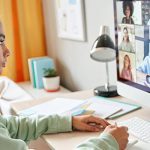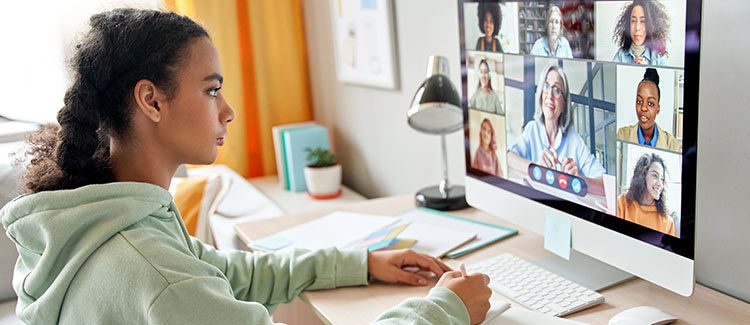In 2016, when Kareem Farah started teaching math at Eastern High School in Washington, D.C., he quickly realized what a daunting challenge he faced to teach, and reach, his students. Some regularly experienced such intense trauma at home and in their neighborhoods that they were barely hanging on academically. Those struggling the most were often absent. Many other students who showed up to class regularly had trouble focusing on classwork.
“I realized the traditional approach of delivering information live is deeply inequitable and deeply unresponsive to students’ needs,” Farah said. So he and fellow teacher Robert Barnett upended the system. They created a blended learning classroom that, they hoped, would give all students the education they deserved.
A blend of in-class and online learning
Blended learning is a broad term used to describe a relatively new form of teaching that takes advantage of technology, while changing the role of the teacher. Traditionally, teachers are a “sage on the stage”. But blended learning turns teachers into more of a “guide on the side” who acts as an educational coach. When blended learning is done well, students become more active learners than in a traditional classroom. Rather than listening to lectures, they are called upon to follow online lessons at their own pace and to collaborate with their fellow students.
While some forms of blended learning use very little technology, others rely heavily on online learning to engage students and deliver educational content. Thomas Arnett, a senior research fellow at the Clayton Christensen Institute, says that by using online learning even when students are in the classroom, teachers can do a better job of supporting students. It’s especially effective, he notes, for kids who are struggling for several reasons: Blended learning makes it easier for teachers to personalize instruction; it gives students more control over their education; and it increases the amount of one-on-one interaction between teachers and students.
Critics worry that some schools try to replace teachers with computers and so deprive students of important, in-person instruction. But according to proponents like Andy Calkins, director of Next Generation Learning Challenges, so long as it’s done well, the opposite is true. Teachers in blended learning classrooms “say they have deeper conversations and interactions with their children than before.”
Plus, even more than traditional school, blended learning schools can help set students up to succeed by allowing them to learn on their own timetables, outside a school building. This is invaluable for students with scheduling conflicts, a family crisis, or an illness. It’s also a game changer for students with learning differences who are permitted to work at their own pace.
Giving students critical life skills
In most blended learning models, teachers give students frequent online assessments. This allows them to easily gauge whether students are on track, ready to move on, or falling behind.
A strong blended learning program also focuses on what’s known as “active learning,” with students working independently and together. Rather than providing content to the class in lectures, teachers work with students one-on-one or in small groups, providing help when needed.
This encourages a sort of teacher-student educational partnership, says Clayton Christensen Institute’s Arnett, and teaches students to take “greater responsibility for [their] own learning,” which he adds, is good preparation for life “out in the real world.”
The many faces of blended learning
There are three basic blended learning models: Flipped classrooms, stations, and a la carte.
Flipped classrooms is the most common form of blended learning. It upends the usual approach that has teachers delivering new material in class (often in a lecture). Instead, teachers provide new materials that students are assigned to review on their own. Later, in class, students do related assignments to review, practice, and build on that information, frequently in collaboration with classmates.
After Farah realized the shortcomings of his live classroom lectures, with so many students absent or not engaged, he and Barnett replaced those lectures with their own six- to nine-minute videos that students could watch when they chose. Then in class, students did assignments related to a given video, with everyone working on the same topic but at their own level and speed. “Instead of simply delivering information,” says Farah, who with Barnett founded the Modern Classrooms Project to promote their blended learning approach, “the teacher is available at all times. You’re going to work with them until they master the skill.”
The second blended learning model is stations. This model has students move between learning stations. In an English class, for example, students at one station write vignettes inspired by the novel they’re reading. At another, they might do a grammar lesson. At a third, they’ll join a group to discuss the novel’s theme. These small groups can make it easier for students to learn through collaboration — an important learning method — and for teachers to interact more directly with their students.
A la carte, the third blended learning method, allows students to choose from a list of available classes, including in-person and online courses. The online offerings provide flexibility for students who have difficulties attending during a set school schedule. A la carte blended learning can also increase the number of classes a school can offer. This model is far more virtual than the other two. Students do most of their work online, except for a few hours a week when they meet in person with teachers and other students.
The challenges, and future promise, of blended learning
Switching from strictly classroom-based schooling to blended learning comes with many challenges. Most models rely on at least some technology — including student access to individual devices — and that costs money. What’s more, teachers need training to adapt to this new form of learning. Blended learning requires that teachers are comfortable giving up their role as traditional teachers, Calkins says, and instead acting as “facilitators” and “managers of learning.”
While blended learning has been around for at least two decades, the many styles of blended learning make it difficult to assess its effectiveness, Arnett says. “It’s like trying to study hummingbirds, eagles, ostriches, and penguins together to determine whether wings allow a bird to fly.”
Some results from larger studies are encouraging. A 2019 meta-analysis of 114 studies on flipped classrooms (the most prevalent type of blended learning) in the U.S. and elsewhere found that flipped classrooms resulted in an improvement in learning outcomes as long as students received the same amount of face-to-face class time as in a traditional classroom. (There was no improvement in student satisfaction.) “We conclude that a flipping the classroom (FTC) approach is a promising pedagogical approach when properly designed,” the researchers write.
But there are also less promising findings on blended learning’s effectiveness. A 2021 study found that blended learning schools tend to have a high student-teacher ratio compared to regular public schools. What’s more, graduation rates at 176 blended schools was only 64.3 percent, which is far below the national average of 85 percent.
Still, Gary Miron, a researcher who co-authored this study and others that show blended learning’s limits, argues that despite the mixed results, today’s technology will create new opportunities for all students. “Blended learning is going to be the future,” Miron says. What’s needed, he adds, is more research on all blending learning models, “to figure out the best way to deliver an education.”
After a year of extensive online and hybrid learning during the pandemic, it’s clear that schools worldwide have been part of a national experiment in blended learning. Time will tell if this model will be adapted and used permanently, and if students will benefit from this blend of online and in-class learning.
What to look for in blended learning classes
When done well, you’ll see:
- Teachers working with students individually and in groups.
- Work tailored to a student’s abilities, interests, and ways of learning.
- Frequent assessments that determine a student’s mastery of concepts and skills.
- Teachers who are well-trained in blended learning and willing to adapt to this new style of teaching.
When done poorly, you may see:
- Too-large classes that make it difficult for teachers to give the necessary individual attention.
- An overuse of technology with little in-person teaching and interaction.
- Students moving to a new topic too quickly without having mastered the previous one.
The next steps…
For parents
To decide if blended learning program might work for your child, ask:
- Does my child have needs that are not being met in a traditional classroom? These can include a health issue that forces them to miss school or a talent for math that makes the standard curriculum and pace boring.
- Are the teachers trained in blended learning? How much time do they spend with students one-on-one?
- Blended learning gives students more control over their education. Ask whether your child is ready to take on more responsibility for their education.
For educators
- Many parents may be unfamiliar with blended learning and not see its educational value. The school staff should explain how blended learning works and enlist them as allies.
- Most blended learning models substantially change the teacher’s role in a classroom, away from delivering content to supporting and assessing students. Consider whether you are comfortable with this and what help you might need to be effective in this role.
For administrators
- Before deciding to pursue blended learning, consider the unique challenges facing your students: Do you have diverse classes making it hard for teachers to meet the needs of all students? Do a lot of students have demanding outside commitments?
- Blended learning is less likely to be successful when districts put technology first. First determine what your goals are, then explore if, and how, technology can help you meet those needs.
- Do you have the resources to acquire and support any technology you would need and resources to train teachers? Will your teachers be open to adapting to a new form of teaching?
For teachers and administrators
Draw on these resources to learn more about blended learning:
- Blended Learning Universe, part of the Christensen Institute, does research and provides materials.
- “Personalized Learning at a Crossroads,” a report by the Center on Reinventing Public Education (CRPE), is a good primer on how blended learning can help support individual learners.
- Blended: Using Innovation to Improve Schools, Michael B. Horn and Heather Stake (2014) and their 2017 followup, The Blended Workbook: Learning to Design the Schools of the Future.
This article is part of our Transforming High School series, a collection of stories, videos, and podcasts exploring the practices that prepare students for success in college and beyond.






